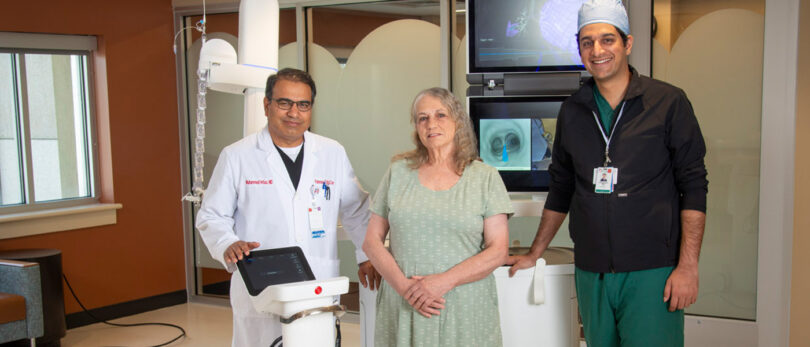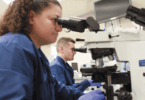Experience precision in lung care with Ion robotic bronchoscopy at UHS
At UHS, our teams are dedicated to innovating care, from diagnosis to treatment. We are proud to offer the Ion, a robotic-assisted bronchoscopy tool used to perform lung biopsies with precision.
Physicians use Ion to access all 18 segments of the lungs to assist in the early detection of lung cancer. The system is equipped with an ultra-thin and highly maneuverable catheter, which facilitates navigation into the far reaches of the peripheral lung. This advanced technology improves access, stability and precision compared to traditional manual techniques, offering a more effective approach to diagnosing and treating lung conditions.
“Quite honestly, it’s the latest and greatest in technology in terms of bronchoscopy,” says Trevor Flanagan, MHA, BS, RRT, manager of Pulmonary Services at UHS.
For the Pulmonary Department, the Ion gives physicians a chance to intervene and diagnose cancer early, before symptoms occur, for those who have regular screenings—ultimately saving lives.
Candita Lee believes that’s exactly what happened to her after she received the Ion robotic bronchoscopy this summer. Ms. Lee was admitted to the hospital for a gastrointestinal bleed. Yet, when a CT scan of her abdomen showed a mark of concern in her lung, exploration began.
The Role of Ion Technology
A pulmonologist recommended she have a bronchoscopy and PET scan to determine if the mark from her CT scan was indeed cancer. With the help of the Ion, the pulmonary and cardiothoracic teams were able to detect and remove the tumor and the lobe, leaving her cancer-free with no need for radiation.
“I know a lot of people just shy away from and won’t get any procedures done, and that’s just not the answer because it turned out the tumor I had was very aggressive,” says Ms. Lee. “So it was by luck that they found it, and I’m glad it’s gone.”
With a prior surgical history, Ms. Lee expected a difficult path toward recovery. However, the Ion procedures ensured that she had little to no discomfort after waking up from general anesthesia.
“I would never have known I had a procedure done,” she says. “No sore nose, throat or chest pain. No vomiting, no nausea, no problem.”
“I would never have known I had a procedure done. No sore nose, throat or chest pain. No vomiting, no nausea, no problem.” – Candita Lee
The Ion gives patients like Ms. Lee a minimally invasive chance to catch cancer, even in previously hard-to-reach areas of the lung. After visiting with a pulmonologist in an outpatient setting, patients are scheduled for the procedure and given an official pathology diagnosis just a week post-op.
“Most people that have lung cancer don’t have symptoms early on in the disease process. Our goal is to screen as many high-risk patients as possible, find those asymptomatic nodules, and intervene and diagnose cancer at early stages in order to treat and save lives,” says Mr. Flanagan.
If you are at risk for lung cancer,
request a lung screening with UHS for early detection at nyuhs.org.







